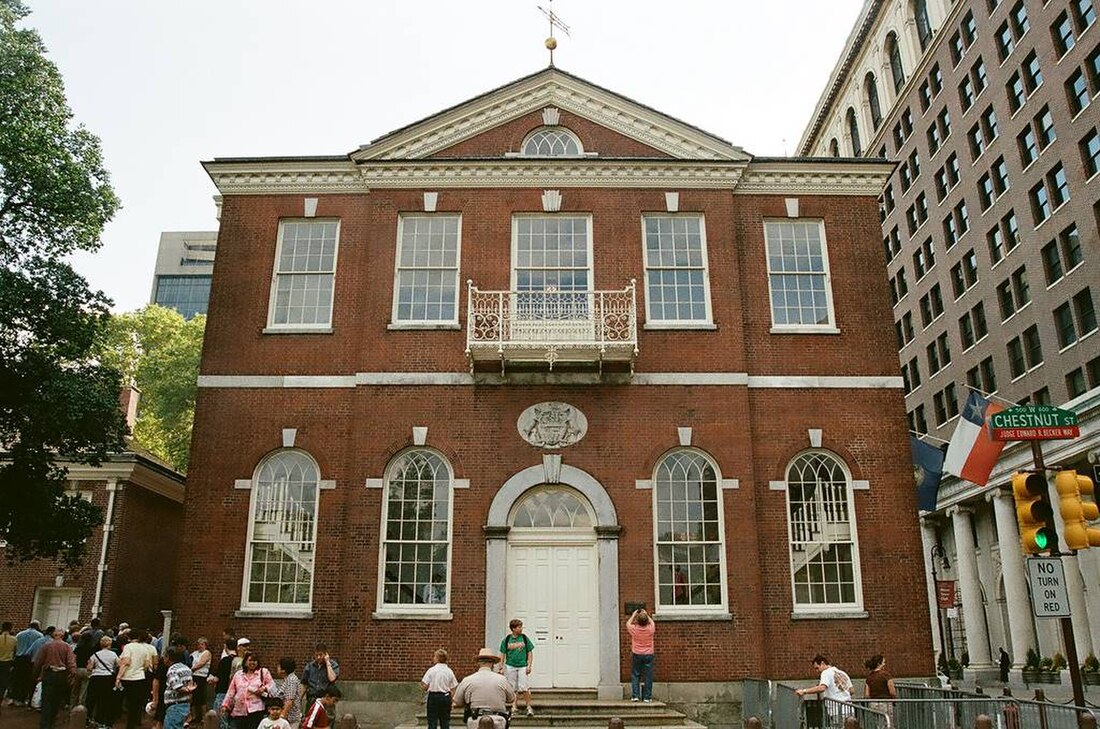Top Qs
Timeline
Chat
Perspective
4th United States Congress
1795–1797 meeting of U.S. legislature From Wikipedia, the free encyclopedia
Remove ads
The 4th United States Congress was a meeting of the legislative branch of the United States federal government, consisting of the United States Senate and the United States House of Representatives. It met at Congress Hall in Philadelphia, Pennsylvania, from March 4, 1795, to March 4, 1797, during the last two years of George Washington's presidency. The apportionment of seats in the House of Representatives was based on the 1790 United States census. The Senate had a Federalist majority, and the House had a Democratic-Republican majority.
Remove ads
Major events
- September 17, 1796: George Washington's Farewell Address warned against partisan politics and foreign entanglements.
- November 4 - December 7, 1796: 1796 United States presidential election: Incumbent vice president John Adams defeated Secretary of State Thomas Jefferson.
Major legislation
Treaties ratified
- June 24, 1795: Treaty of London ("Jay's Treaty")
- March 7, 1796: Treaty of Madrid ("Pinckney's Treaty")
States admitted
- June 1, 1796: Tennessee admitted as a state; formerly the Territory South of the River Ohio, Sess. 1, ch. 47, 1 Stat. 1 - 491 491
Party summary


This was the first Congress to have organized political parties. Details on changes are shown below in the "Changes in membership" section.
Senate
House of Representatives
Remove ads
Leadership

Jonathan Dayton
Senate
- President: John Adams (F)
- President pro tempore:
- Henry Tazewell (F), first elected December 7, 1795
- Samuel Livermore (F), first elected May 6, 1796
- William Bingham (F), first elected February 16, 1797
House of Representatives
- Speaker: Jonathan Dayton (F)
Members
Summarize
Perspective
This list is arranged by chamber, then by state. Senators are listed by class, and representatives are listed by district.
Senate
Senators were elected by the state legislatures every two years, with one-third beginning new six-year terms with each Congress. Preceding the names in the list below are Senate class numbers, which indicate the cycle of their election. In this Congress, Class 1 meant their term ended with this Congress, requiring re-election in 1796; Class 2 meant their term began in the last Congress, requiring re-election in 1798; and Class 3 meant their term began in this Congress, requiring re-election in 1800.
Connecticut
Delaware
Georgia
Kentucky
Maryland
Massachusetts
New Hampshire
|
New Jersey
New York
North Carolina
Pennsylvania
Rhode Island
South Carolina
Tennessee
Vermont
Virginia
|
 2 Democratic-Republicans
1 Democratic-Republican and 1 Federalist
2 Federalists |

|
House of Representatives
Remove ads
Changes in membership
Summarize
Perspective
The count below reflects changes from the beginning of this Congress
Senate
There were 10 resignations, 2 new seats, and 1 election to replace an appointee. There was a 1-seat gain for both the Federalists and the Democratic-Republicans.
House of Representatives
There were 9 resignations, 1 death of a Representative-elect, and 1 new seat. There was a 1-seat gain for both the Federalists and the Democratic-Republicans.
Remove ads
Committees
Lists of committees and their party leaders.
Senate
House of Representatives
- Claims (Chairman: Uriah Tracy then Dwight Foster)
- Commerce and Manufactures (Chairman: Benjamin Goodhue then John Swanwick)
- Elections (Chairman: Abraham B. Venable)
- Revisal and Unfinished Business (Chairman: Nicholas Gilman)
- Rules (Select)
- Ways and Means (Chairman: William Loughton Smith)
- Whole
Joint committees
- Enrolled Bills (Chairman: N/A then Richard Stockton)
Officers
Senate
House of Representatives
See also
- 1794 United States elections (elections leading to this Congress)
- 1796 United States elections (elections during this Congress, leading to the next Congress)
Notes
References
External links
Wikiwand - on
Seamless Wikipedia browsing. On steroids.
Remove ads


